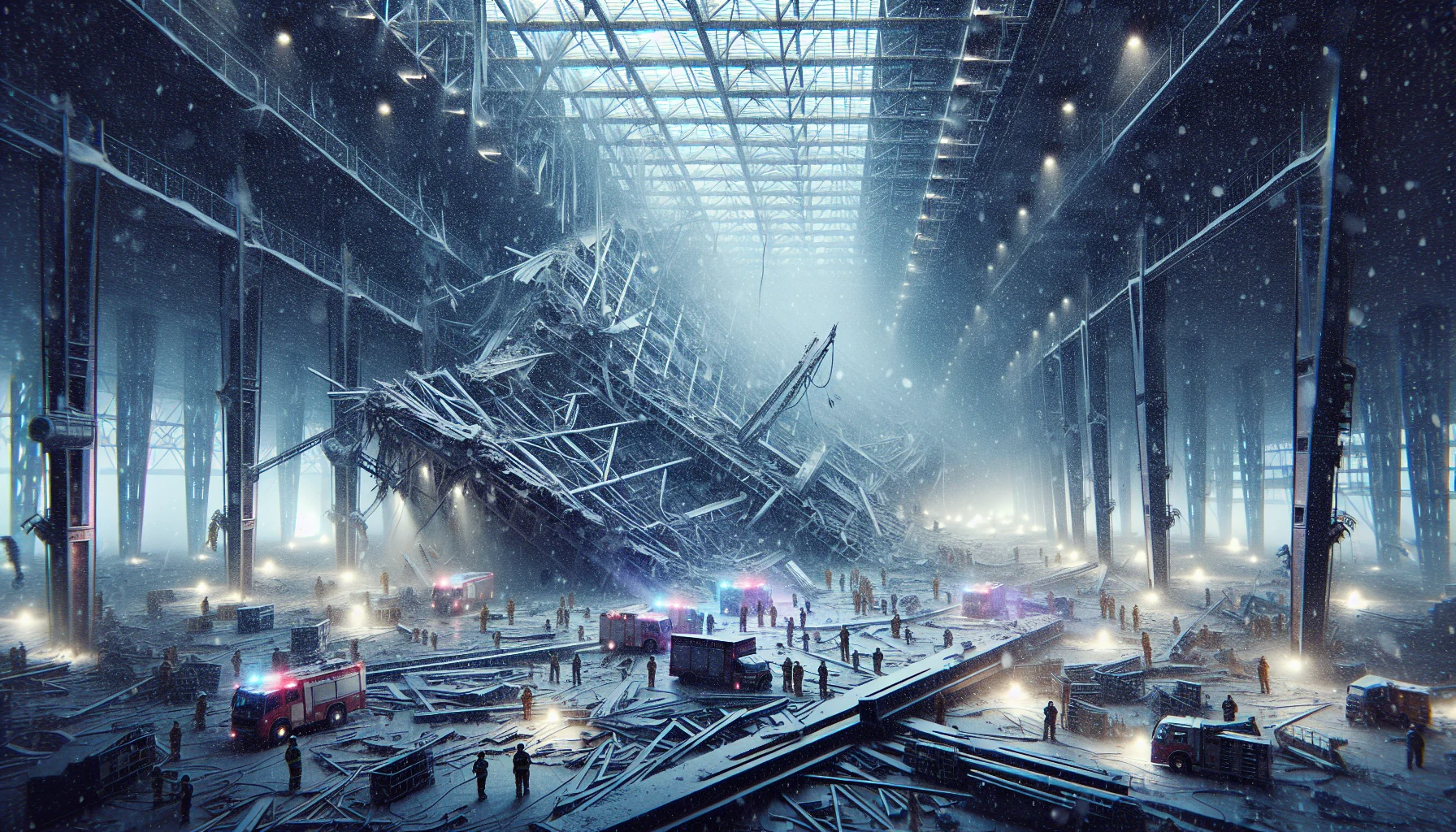
Katowice Trade Hall Roof Collapse
by: The Calamity Calendar Team
January 28, 2006
A Day Like Any Other
In the heart of the Katowice urban area, Chorzów's Katowice International Fair had long been a beacon of innovation and cultural exchange. Established in 1963, it was a true pillar of Polish commerce and society, hosting countless exhibitions and trade fairs over the decades. January 28, 2006, however, marked a departure from routine as the fair welcomed hundreds of exhibitors and thousands of visitors to a national pigeon racing exhibition, an event buzzing with excitement and anticipation.
As morning sunshine filtered through the crisp winter air, the trade hall stood proud and bustling. Underneath the flat expanse of its steel-lattice roof, visitors admired the array of pigeons and chatted with fellow enthusiasts. However, this seemingly straightforward morning would unveil a narrative intertwined with foreboding signs and, ultimately, tragedy.
The Unfolding Precursor
By midday, the trade hall was a lively scene filled with the aroma of coffee and the murmur of various languages as exhibitors set up their stalls. Yet, as the day advanced into the afternoon, a subtle shift began to cast a shadow over the bustling crowd. Several attendees reportedly overheard creaking sounds reverberating through the hall. Such noises, though unsettling, were brushed aside amidst the hubbub.
Even as evening drew near and the temperature outside dipped below freezing, the warmth of lively conversation continued to fill the space. Around 5:00 PM, the ceiling hinted at betrayal with slight, almost imperceptible shifts. Some onlookers noted this unusual occurrence, but without an immediate threat, the rhythm of the exhibition proceeded uninterrupted.
The Catastrophe Unravels
At precisely 6:00 PM, the turn of events was both sudden and devastating. Without warning, the immense weight of accumulated snow, coupled with structural vulnerabilities, overwhelmed the hall’s roof. What could have been a crinkle in the pages of history turned into a cacophony of shattering metal and falling debris as the roof collapsed into the confines of the trade hall.
Scattered screams of disbelief and desperation echoed through the chaotic venue as darkness replaced the neoteric might of electric lights. Steel beams crashed to the ground, ensnaring everything beneath them, from exhibition stalls to those attending the event. The air, now a frosty mixture of dust and snow, carried the harrowing cries of those trapped within.
Thanks for subscribing!
Heroes Amidst Ruins
The response to the nightmare was swift, as emergency sirens wove a mournful symphony over the night sky. Emergency services including the fire brigade, local police, and military units raced against time to the scene. Under the guidance of floodlights and blanketed by thick snow, rescuers worked feverishly amidst the wreckage.
Rescue teams, augmented by specially-trained dogs, scoured the site tirelessly. They painstakingly combed through the wreckage, guided by hope and the muffled cries of survivors. Every save was a triumph against despair, though not all had such fortuitous outcomes.
As night stretched into morning, the full gravity of the tragedy came to light. Sixty-five individuals, including visitors from abroad, had perished. The injured numbered over 170. Those affected were more than just statistics; they were fathers, mothers, children, and friends whose lives were irrevocably changed in an instant.
Aftermath and Awakening
In the wake of such profound loss, the focus turned to reflection and renewal. The Katowice Trade Hall collapse sent ripples through Poland and beyond, demanding accountability and change. Investigations traced the calamity to a perfect storm of design flaws and excessive snow load, exposing the consequences of neglected maintenance.
The tragedy prompted an overhaul of building safety standards across Poland, with rigorous new regulations enacted to prevent the repetition of such a catastrophe. Structures with flat roofs became the focal point of renewed inspections, ensuring they could withstand the burdens imposed by heavy snowfall.
Criminal charges followed as the justice system held accountable those implicated in the building’s design negligence and management failures. Acknowledging these oversights was just a part of coming to terms with the tragedy that had been etched in the memories of those affected.
Lessons Carried Forward
The Katowice Trade Hall roof collapse remains a poignant reminder of the fragility of human constructs against nature’s force and negligence's hand. Its lessons resonate not just within the architectural and regulatory circles but also in the shared narrative of Polish communities bound by tragedy—and the steadfast resolve not to let history repeat itself.
Though the trade hall itself has long been cleared of debris, the echoes of that fateful day resonate in the tightened regulations and safety measures now emblematic of buildings across Poland. Lives lost and changed forever testify to the collective need to prioritize safety and vigilance in our built environment, ensuring that tragedies of the past inform a safer future.
Stay in the Loop!
Become a Calamity Insider and get exclusive Calamity Calendar updates delivered straight to your inbox.
Thanks! You're now subscribed.